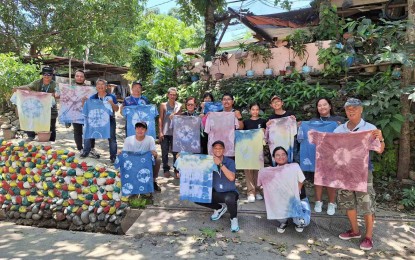
'DYEING' ART. Participants of the Lakbay Aral in Peñarrubia, Abra show off their naturally-dyed shirts in this undated photo. They were taught by Luis Agaid Jr., son of the Father of Natural Dye and member of the Itneg-Illaud tribe that helps preserve their natural dyeing and hand embroidery heritage. (Photo courtesy of CARD-MRI Hijos Tours)
PEÑARRUBIA, Abra – Agkulol, the art of natural dyeing using materials from nature and the hand embroidering using designs or characters unique and patented by the tribe, continues to be preserved and promoted by the Itneg-Illaud tribe in this town's Barangay Namarabar.
Luis Agaid Jr., son of his namesake and renowned Father of Indigenous Natural Dye Luis Agaid Sr., said preserving their tribe’s heritage brings pride and livelihood to the people in their community.
He said they are still using the indigo plant in dyeing along with other organic materials such as barks of trees or leaves of medicinal plants such as lagundi (chaste tree).
“Sa natural dyeing versus synthetic, at least alam mo na ang ginagamit ay medicinal plants. Mas matibay talaga ang synthetic pero ‘di alam ano mga ginagamit na chemicals (In natural dyeing, at least we know that we are using medicinal plants. Synthetic dyeing is more long lasting but we do not know what chemicals they are using),” he added.
Agaid said the use of the indigo plant as natural coloring for clothes and textiles was passed down to them by their forefathers who initially used the plant for medicinal purposes.
“Ang mga ninuno namin gamit lamang noon itong indigo para sa katawan, panggagamot at iba pa po. Ang indigo ay medicinal plant. Ito iyong ginagamit sa alipunga dahil antibacterial ito (Our forefathers used indigo as medicine for their bodies, among its many uses. Indigo is a medicinal plant. It was used to treat athlete’s foot and other fungal infection because it has antibacterial properties),” he said.
Indigo was eventually used as a coloring material when weaving textile to make clothes.
"Ito ay pinreserve at ginamit na pangkulay dahil sa paniniwala po nila ito ay galing sa Kabunian na binigay sa tribu noong unang panahon (It was preserved as a coloring because they believe it comes from Kabunian [deity] that was given to our tribe from ancient times),” added Agaid, whose family grows indigo plant in their 10-hectare land.
He said there is a high demand for natural dye from indigo overseas, especially in European countries.
This demand, he added, has helped them not only to preserve their heritage but also provide them with livelihood.
“May demand at may mga bumili at plan na gawing anti-bacterial soap and food processing someday with the help of the Department of Science and Technology (There is a demand for the plant and there are buyers planning to make it as an antibacterial soap and in food processing with the DOST's help),” Agaid said.
Among the organizations helping them in their advocacy is the Center for Agriculture and Rural Development Mutually Reinforcing Institutions Incorporated (CARD-MRI Inc.), he added.
As the women of the Itneg-Illaud tribe, they specialize in hand embroidery using unique and patented designs and characters in their abel or cloth.
Josephine Mina, one of the hand-embroiders, said among the characters they are known for are the lizard, frog, a man, and a woman, which have different meanings in their tribe. These designs are embroidered into vests, boleros, and coats, among others.
The group also sells their products in trade fairs and via social media (Revival Dye), and lets tourists visit their village to personally see how the products are made.
Community immersion
CARD-MRI Hijos Tours, a travel tour company that offers home-stay heritage tours across the country, said community-based trips that involve immersion in these villages help safeguard both their tangible and intangible cultural heritage.
Accredited by the Department of Tourism, the company recently held a "Lakbay Aral" tour in Abra and Vigan City for media practitioners from Pangasinan, Bulacan, and Tarlac, in which they interacted with members of the Abra tribe, among other activities.
“The focus is not the typical travel leisure; we are an interpretation company. Hijos tours dig deeper on how this information makes sense to the travelers and to CARD members,” said the company's deputy director Raffy Antes.
“We do (a) more interpretation approach not much on leisure travel but fun and meaningful experience making sense of the story of our heritage,” he added.
Other activities include the visit to the empanada-maker where tourists prepare and cook their own empanada and drive the kalesa (horse-drawn carriage) at Calle Crisologo in Vigan City.
The company currently offers tours in Laguna, Baguio, Leyte-Samar, Iloilo, Davao, Legazpi, and Abra-Vigan, with plans to expand in Mindoro and Tawi-Tawi.
Minnie Alcaide, one of the participants, said she enjoyed the trip as she got the chance to know more about the Itneg-Illaud and other communities in Vigan City. (PNA)
